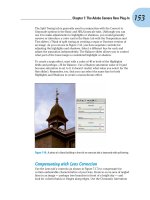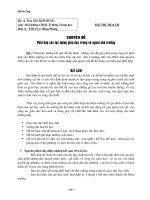getting trading edge and idea - diamondwisechartingsorting - ye 2010
Bạn đang xem bản rút gọn của tài liệu. Xem và tải ngay bản đầy đủ của tài liệu tại đây (1.39 MB, 28 trang )
Getting Trading Edge and Idea
by
Diamondwise Charting and Sorting
By Dr. Jay “EdgeMe” Ye
Copyright © 2010 by Jay “EdgeMe” Ye, All rights reserved.
No part of this publication may be reproduced, stored in a retrieval system, or
transmitted in any form or by any means, electronic, mechanical, photocopying,
recording and/or otherwise, without the prior written permission of the author.
The author has used his best efforts in preparing this book, and the information
provided herein is provided "as is." The author makes no representation or
warranties with respect to the accuracy or completeness of the contents of this
book. Under no circumstances shall the author be liable for direct, indirect,
special, incidental, or consequential damages resulting from the use, misuse, or
inability to use this book or the software associated with this book.
The product names and services known to be trademarks, registered trademarks
used throughout this book are in an editorial fashion only.
V0.1, updated in 12/30/2010
Show me the charts, and I'll tell you the news.
- Bernard Baruch
Table of Contents
1. Introduction
2. Good and Bad Behaved Stocks
3. The UP and DN Numbers
4. The Hint and RV Numbers
5. Look Thru Many Charts Without Typing the Symbols
6. Spatial Searching
7. Hint Searching
8. RealTime/Intraday Support
Introduction
This Excel-based tool has two major functions; one is diamondwise charting,
another is spatial and hint searching;
I also call this tool “The ideas generator”, because it can find many trading
ideas/opportunities for you.
What is diamondwise charting?
To answer this question, I’d like to present a geometry problem:
In triangle ABC, let D be the midpoint of BC. If angle ACB=30 degrees and
angle ADB= 45 degrees, find angle ABC.
Try to solve the above the problem, the answer will be presented near the end of
this article.
I don’t know about you. I cannot solve this geometry problem without drawing
auxiliary lines. I still remembered in my middle school years. Many times, I got
stuck on a geometry problem. However, after my teacher drew some auxiliary
lines, I knew the answer right away, “Ah-ha”.
I like to call “auxiliary lines” as “helper lines”.
These helper lines will give you the “Ah-ha” moment.
Diamondwise charts are charts with “helper lines”. There are two sets of parallel
helper lines in the plot, one is up slope helper lines, and another is down slope
helper lines. These two sets of lines form many diamonds (That’s why I called
them “diamondwise” charts). Below is an example of diamondwise chart for
SPY:
The price and time space is divided into grids of diamonds. The size and the
shape of the diamond (the slope and distance of these helper lines) are
determined by the behavior of the stock.
Good and Bad Behaved Stocks
Stocks are like people. Some people are good people, while some others are
people with bad behavior. You want to be surrounded by good people, just like
you like to play with good behavior stocks.
Look at the two stocks (FSLR and NFLX):
FSLR moves all over the places, while NFLX moves nicely within 2 channels;
FSLR is an example of a badly behaved stock. On the other hand, NFLX is a
good behaved stock.
The ISRG is also a good trending stock, it moves down within 2 channels.
AMZN is also a stock with good behavior. Its movement (down and up) are
mostly within channels.
The diamond edges can be supports or resistances, i.e. both up slope and down
slope helper lines can be support or resistance line. The lines above the current
price are resistance and lines below the current price are support lines.
The UP and DN Numbers
• UP number: The distance to the critical UP trend/helper line. If it is
above the UP helper line, then the number is positive, otherwise it is
negative number
• DN number: The distance to the critical DOWN trend/helper line. If it is
above the DOWN helper line, then the number is positive, otherwise it
is negative number
For JNY, the distance to up trend line is 3 (UP=3, 3 is normalized number,
no unit), and the distance to down trend line is 6 (DN=6).
You can also think of UP and DN numbers as trends:
• UP number: the longer term trend, positive number means up
trend, negative number means down trend
• DN number: the short term trend, positive number means up
trend, negative number means down trend
For example, MEE’s chart shows UP= -1 (longer term is still negative, i.e.,
down), and DN=12.(short term, the UP trend is very strong)
INTU’s UP=2, DN=4, both long and short term trend are up:
You can use UP and DN numbers to rank/compare two stocks to see which stock
is better. On Dec.29, 2010, AAPL (UP=4, DN=2) is better than GOOG(UP=2,
DN=1) in terms of trending strength:
pattern. In “Spatial Searching” section below, I will describe how to search stocks
using UP and DN numbers.
The Hint and RV Number
A “hint day” is a day when a stock shows one of the following:
• Price closes up or down over 1.5 normal daily range (StdDev)
• Large white candle or Black candle body
• Very high volume
• Break Up (at/near the highest peak) or Break Down (at/near lowest valley)
A "hint" just tells us the stock may worth further research. The same kind of “hint
day” may have different meanings in different trends or price zones. For
example, a “hint day with high volume big white candle” in a down trend stock
may hint trend change, while the same “high volume big white candle up hint
day” near trading range may means a break up for the stock.
Numeric numbers are used for Hint for easy searching. The hint number is
defined as
• Hint = 1, the stock’s open to close (white candle body) is over 1 stdDev
• Hint = 2, the stock move up over 1.5 stdDev
• Hint = 3, the stock had hint=2 or 1 within last 5 days
• Hint = -1, the stock’s close to open (black candle body) is over 1 stdDev
• Hint = -2, the stock move down over 1.5 stdDev
• Hint = -3, the stock had hint =-2 or -1 within last 5 days
• Hint = 0, normal stock fluctuation days
RV, relative volume, is defined as current volume divided by 20 days moving
average volume. RV is used to determine the strength of the hint. When we have
Hint =2, we also want to see RV > 1.
Below are recent Hints for CERN:
When you are looking for low volume pullback, you can look for Hint=3, RV<1
Below is a “buy on dip” (Hint=3, RV<1) example for BDX
In summary, we believe every big trend starts with a hint day. The best traders
search only for the very best opportunities when their trading methods have an
edge. You have to let the market give you a “hint” before you act.
If you don’t want to miss the best opportunities, you have to scan the “hints” on
the list of stocks everyday. In the “Hint Searching” section, I will describe how to
scan stocks using Hint and RV numbers.
Look thru Many Charts Without Typing the Symbols
I have to look through many charts each day to search for opportunities. To me, it
is too tedious to type in stock symbols every time I want to see them. This is one
of the motivations for me to develop my own charting software.
In the diamondwise Excel file, there is a sheet called watchlist. A list of stocks
that I am interested in could be stored in Column A. All you have to do is move
you mouse into the Column A, then use the arrow down key or simply hit Enter.
The diamondwise chart for the selected symbol will be drawn. In that way, you
can go thru all the stock charts without typing symbols.
Of course, if you like to type the symbol, just type the symbol in cell B1, then hit
the enter key, the diamondwise chart will be shown.
If you want to have more watch list sheets, just go to Edit menu, choose Move or
Copy Sheet. That way, you can organize your watch list or positions very easily.
Spatial Searching
You can search stocks per their UP and DN numbers. You can easily find stocks
in certain spatial diamonds.
Go to Sorting sheet,
1. Click the Update button to calculate UP and DN numbers for each stock.
Please note this button only needs click once unless new stock data have
been downloaded again.
2. Type the UP and DN number into C1 and D1 cells.
3. Click Spatial Sorting button
The stocks which met your UP and DN numbers will be left shown, other stocks
will be hidden.
For example, the following screen shows UP=2, DN=2, all stocks with UP=2 and
DN=2 will be shown.
In the C1 and D1, you can also use > or < in addition to the numeric value,
For example, you can type >1 in C1 cell, than >2 in D1 cell; that means you want
to search for stocks with UP higher than 1, and DN higher than 2:
Just click the symbols on Column A, the diamondwise chart will be drawn.
As indicated earlier that UP number is really longer term trend and DN number is
the short term trend.
One scan I always like to do is find long term trend is UP (UP>1) and the short
term trend is just break out the short term downtrend line (DN=1).
For the above scan, all I have to do is to enter >1 into cell C1 and 1 into cell D1:
The chart below shows the recent scans (UP>1 and DN=1) for ROVI:
In summary, just remember Cell C1 is for UP number, D1 cell is for DN number.
You can do all kinds of spatial searches. It is really all up to your imaginations.
With these kinds of scans, you will be surrounded by good stocks; you will have
more chance to be correct.
Hint Searching
Hint number is entered in E1 cell, and RV number is entered in F1 cell.
Some typical searches I will do are:
• Hint=2, RV>1; search for stock up over 1.5 stdDev with above average
volume
• Hint=1, RV>1; search for stock with big white candle with above average
volume
• Hint=-2, RV>1; search for stock down over 1.5 stdDev with above average
volume
• Hint=-1, RV>1; search for stock with big black candle with above average
volume
• Hint=3, RV<1; search for stock was up big, then pullback on light volume
• Hint=-3, RV<1; search for stock was down big, then rally on light volume
When the market is in buy mode (use our Bulls vs Bear Model), you may search
stocks from the big white candles (Hint=1) or big mover (Hint=2) with higher
volume (RV>1). If you like to buy on the dips, then use search with Hint=3,
RV<1.
For example, just enter the condition 2 into cell E1, and >1 into cell F1, then click
Hint Sorting button, only stocks met your conditions will be shown:
When the market is in sell mode, you can search stocks have Hint=-1 or Hint=-2
with RV>1. If you like to sell short on low volume bounce then Hint=-3 with RV<1
is a good scan for you.
Once you find a list of stocks met your search condition, you can click Open
FinViz button, then move your mouse to select the list of stocks, then click OK. It
will open Finviz website and plot the list of stocks.









